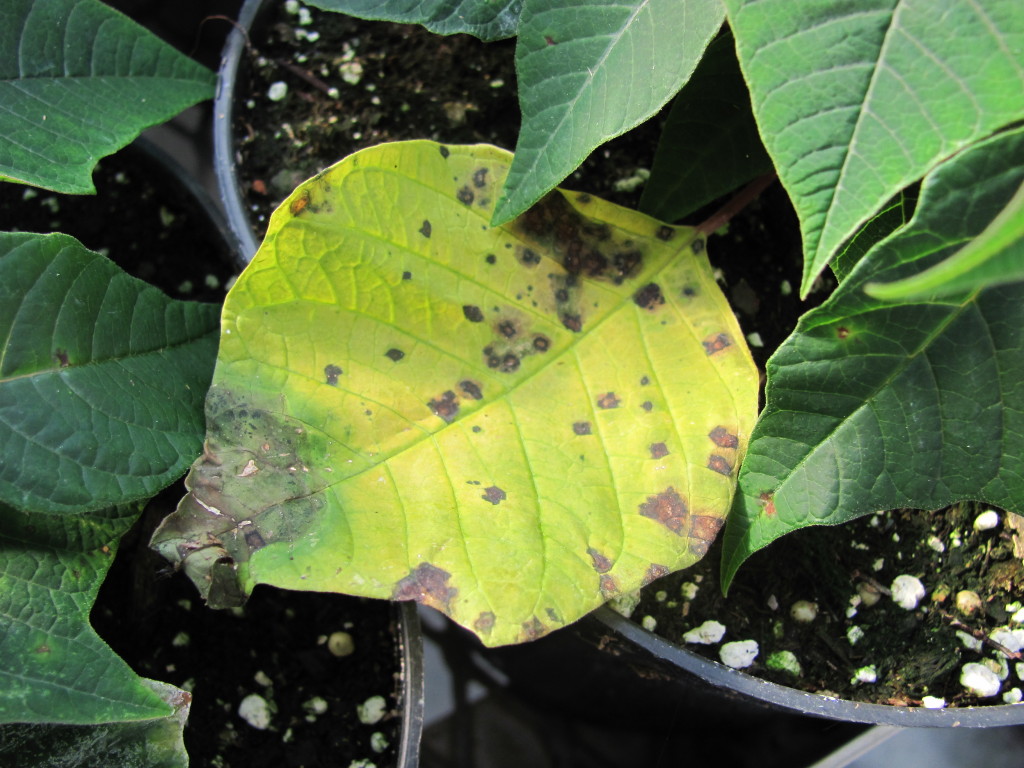
Bactericides for Ornamentals in 2013
I have been working on ornamental diseases caused by bacteria for more than 30 years. This started with diseases of foliage plants at the University of Florida in the 1980s and early 1990s. At that time, the only effective choices were antibiotics (like streptomycin sulfate — Agri-Mycin or Agri-Strep) and coppers (like Phyton 27 and Kocide 101). Control was sometimes poor and sometimes very good but quite variable and, unfortunately, bacterial resistance to either one or both active ingredients was reported frequently.
Early Trials
The IR-4 program, which assists in registrations for minor use crops like ornamentals, identified bacterial diseases as a researchable target starting in 2008. Dr. Dave Norman at the Mid-Florida Research and Education Center for the University of Florida worked quite extensively on Ralstonia (bacterial wilt) on geranium, as well as Erwinia blight on Phalaenopsis and Xanthomonas leaf spot on geranium. Best results in his trials were seen with copper products (such as Phyton 27) and carbamates (such as Protect DF). Antibiotics (Firewall=streptomycin sulfate, Flameout=oxytetracycline and Kasumin=kasugamycin) had variable results. Biologicals (Cease=Bacillus subtilis, Companion=Bacillus subtilis, Taegro=Bacillus subtilis var. amyloliquefaciens and Actinovate=Streptomyces lydicus, strain WYEC 108) were sometimes effective to a limited degree.
In California, we also worked with some of these products through the manufacturer or IR-4. We did two trials on Xanthomonas blight on geranium, one trial on Erwinia cutting rot on poinsettia, and one trial on Pseudomonas blight on lavender. Best control was seen in both Xanthomonas trials with the industry standard, Phyton 27. Kasumin gave very good control of Xanthomonas on geranium at 35 ppm but failed at 100 ppm perhaps due to phytotoxicity. Taegro worked well on Erwinia but did not give any control of Xanthomonas on geranium.
In the other Xanthomonas trial, plants were treated twice before inoculation with a culture of Xanthomonas hortorum pv. pelargonii and once afterward on a weekly interval. Three weeks after inoculation, the lowest numbers of spots were found on the noninoculated controls and plants treated with acibenzolar-S (systemic acquired resistance [SAR] product under devleopment from Syngenta) and Kocide and Phyton 27 (Table 1). Clearly the copper products worked well and although acibenzolar-S is severely phytotoxic to geranium at the rate tested, it was 100 percent effective. The Citrex (citrus extract) provided about 68 percent reduction in number of spots, and the Regalia SC (Giant Knotweed extract) treatment was also somewhat effective at 45 percent reduction in spots. The products that did not work in this trial included Kasumin and Taegro (drench alternated with a spray).
Later Trials
In 2009, we conducted a trial on Erwinia blight on Oncidium orchids (Table 2). In this trial we compared copper products (Kocide 3000 and Camelot) alone and as tank mixes with a quaternary ammonium fungicide/bactericide (KleenGrow, from PACE 49). Products were applied preventively on a weekly interval five times. We rated the number of rotted leaves/plant twice about a week apart. The best overall prevention was achieved with KleenGrow alone, with all other treatments giving slight control. The combination of a copper product and KleenGrow did not work quite as well as KleenGrow alone in this trial. All products were safe on the orchids in this trial.
Our final trial for 2010 was performed on Xanthomonas leaf spot on poinsettias, which suddenly became an issue all over the United States that season. Treatments were applied at least once (Sept. 8) before we inoculated and then continued weekly until the end of the trial. We evaluated Xanthomonas severity, phytotoxicity, bract development and plant height in this trial. A single acibenzolar-S drench or weekly sprays gave excellent prevention of Xanthomonas; but by a month after the end of the trial, we did see significant delay bract coloration. We saw speckling on undersides of leaves with the KleenGrow treatment as well as with Phyton 27. Both products did provide excellent prevention of the Xanthomonas and otherwise did not damage the plants.
The only registered product of those newly tested that works well on bacterial diseases is KleenGrow. I have summarized some other work on KleenGrow for bacterial diseases on many crops in Table 4. KleenGrow shows a range of efficacy depending on the target disease. While it has been excellent on Erwinia soft rot on orchid (6 ounces/100 gallons), it is did not work on Erwinia fireblight on pear when used at 50 ounces/100 gallons. It gave some control in one trial on Pseudomonas on blueberry when used at 50 ounces/100 gallons, but not in one on almonds when used at 12.5 ounces/100 gallons. It appears to really do well on the Xanthomonas diseases it has been tested on including geranium, poinsettia and citrus. I suggest following the label for determining an initial use rate.
Conclusions
It was interesting to see that the results of the older products (especially coppers) were more consistent than many of the newer products. Kasumin provided excellent control in one trial and some control in several others, but appears to have issues with phytotoxicity on some ornamentals. Acibenzolar-S was also phytotoxic on some crops but safe on others. This SAR product only works when used before infection but can be very effective on a wide range of bacterial (and fungal) diseases when used correctly. We have been testing it for the past 10 years or so, and it remains the most consistent new product that may be developed for bacterial diseases of ornamentals. In the meantime, rotations of a copper product and KleenGrow or Cease are usually most efefctive for Xanthomonas and Pseudomonas leaf spots. Rotations of Agri-Mycin and KleenGrow appear to be the best choice at present for Erwinia soft rot.
Bactericides for Ornamentals in 2013


 Video Library
Video Library 




















